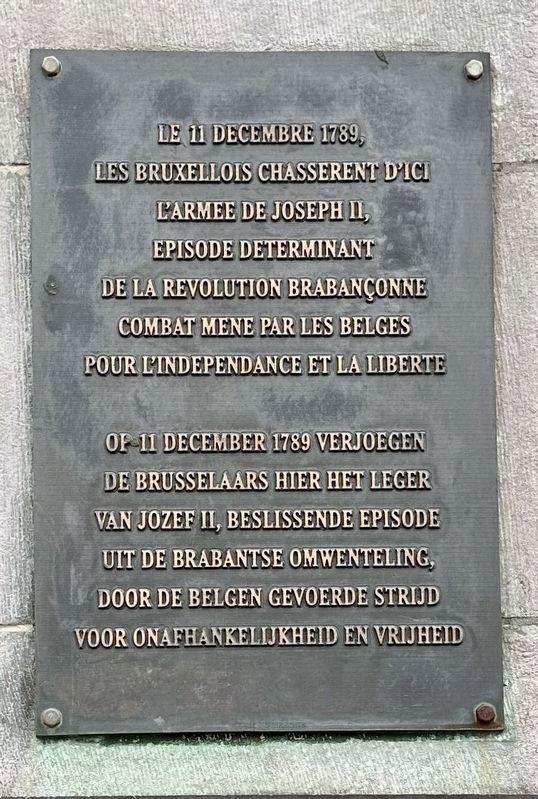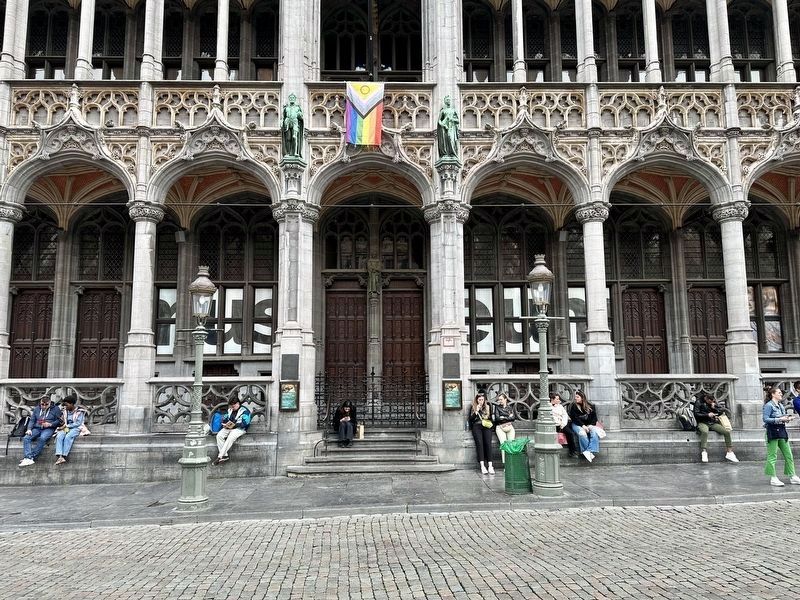Grand Place in Bruxelles, Brussels, Belgium — Northwestern Europe
Expulsion of the Austrian Forces
De 11 decembre 1789, les Bruxellois chasserent d'ici l'armee de Joseph II, episode determinant de la Revolution brabançonne combat mene par les belges pour l'independance et la liberte
Op 11 december 1789 verjoegen de Brusselaars hier het leger van Jozef II, beslissende episode uit de Brabantse Omwenteling, door de belgen gevoerde strijd voor onafhankelijkheid en vrijheid
On December 11, 1789, the people of Brussels expelled from here the army of Joseph II, a decisive episode in the Brabant revolution, the battle waged by the Belgians for independence and freedom.
Topics. This historical marker is listed in this topic list: Wars, Non-US. A significant historical date for this entry is December 11, 1789.
Location. 50° 50.817′ N, 4° 21.161′ E. Marker is in Bruxelles, Brussels. It is in Grand Place. Marker is on Grand Place, on the right when traveling north. Touch for map. Marker is at or near this postal address: Grand Place 29, Bruxelles, Brussels 1000, Belgium. Touch for directions.
Other nearby markers. At least 8 other markers are within walking distance of this marker. The Execution of the Counts of Egmont and Horn (here, next to this marker); Victor Hugo (within shouting distance of this marker); Hôtel de Ville de Bruxelles / Stadhuis van Brussel / The Brussels Town Hall (within shouting distance of this marker); Karl Marx (within shouting distance of this marker); Les Premiers Drapeaux Belges / De Eerste Belgische Vlaggen / The First Belgian Flags (about 90 meters away, measured in a direct line); Verlaine blessa Rimbaud / Verlaine wounded Rimbaud (about 120 meters away); Église Saint-Nicholas / De Sint-Niklaaskerk / The Saint-Nicholas Church / Die Sankt Nikolaus-Kirche (about 120 meters away); Universite Libre de Bruxelles (1834 - 1984) (approx. 0.4 kilometers away). Touch for a list and map of all markers in Bruxelles.
Also see . . .
1. History of the United Belgian States (crwflags.com).
Excerpt: On 24 October 1789, the deposition of Emperor Joseph II was proclaimed by the Insurrection Committee set up by the Belgian patriots (the uprising is known as the Brabantine Revolution). The Austrian garrisons were expelled from Ghent on 17 November and from Brussels on 13 December;(Submitted on December 31, 2023.)on 21 November, Mons was proclaimed a "patriot" town and abandoned by the Austrians. The revolution was completed with the seizure of Namur and the entrance of Van der Noot's army in Brussels on 17 December.
On 21 December 1789, the States General of Hainaut issued a manifesto proclaiming the nation "free, independent and released from the oath of allegiance to Joseph II"….
On 11 January 1790, the Belgian provinces signed a treaty of union and set up the Congress of the United Belgian States. The treaty was signed by representatives of the provinces of Brabant, Gelderland, West Flanders, Hainaut, Namur, Tournai, Tournaisis and Mechelen. The Congress ordered a seal bearing the arms of the signatory provinces, completed with the arms of Limburg, Luxembourg and Flanders.
The United Belgian States were short-lived because of the political divisions among its rulers. Namur was seized without fighting by Marshal de Bender on 25 November 1790, as was Mons on 30 November, and the Austrian rule was quickly reestablished.
2. Brabant Revolution (Wikipedia).
Overview: The Brabant Revolution or Brabantine Revolution (French: Révolution brabançonne Dutch: Brabantse Omwenteling), sometimes referred to as the Belgian Revolution of 1789–1790 in older writing, was an armed insurrection that occurred in the Austrian Netherlands (modern-day Belgium) between October 1789 and December 1790. The revolution, which occurred at the same time as revolutions in France and Liège, led to the brief overthrow of Habsburg rule and the proclamation of a short-lived polity, the United Belgian States.(Submitted on December 31, 2023.)
Credits. This page was last revised on December 31, 2023. It was originally submitted on December 31, 2023, by Andrew Ruppenstein of Lamorinda, California. This page has been viewed 49 times since then and 19 times this year. Photos: 1, 2. submitted on December 31, 2023, by Andrew Ruppenstein of Lamorinda, California.

